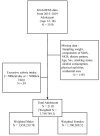Relative Excess Risk of Metabolic Syndrome Due to Interaction Between Handgrip Strength and Dietary Patterns Among Korean Youth
- PMID: 40732907
- PMCID: PMC12300056
- DOI: 10.3390/nu17142282
Relative Excess Risk of Metabolic Syndrome Due to Interaction Between Handgrip Strength and Dietary Patterns Among Korean Youth
Abstract
Background/Objectives: Metabolic syndrome (MetS) in adolescence increases chronic disease risk in adulthood. No study has explored the combined effects of skeletal muscle strength and dietary patterns in MetS. This study aimed to examine the individual and combined effects of dietary patterns and HGS on MetS and its components in Korean adolescents. Methods: Using the 2014-2019 Korea National Health and Nutrition Examination Survey data, a weighted sample of approximately 3.75 million adolescents was included. Dietary patterns were derived using principal component analysis. Relative handgrip strength (HGS) was calculated. Multivariable logistic regression and relative excess risk due to interaction (RERI) were used to assess dietary patterns, HGS, and MetS, stratified by sex and adjusted for age, smoking, alcohol consumption, economic status, residential area, and physical activity. Results: Low HGS was independently associated with a high odds of developing MetS in both men (OR, 1.108; 95% CI, 1.038-1.182) and women (OR, 1.128; 95% CI, 1.047-1.216). In contrast, dietary pattern alone was not significantly associated with MetS. Men with both low HGS and unhealthy dietary patterns (processed fat or Western diet) had higher odds of developing MetS, even though the interaction was sub-additive, as indicated by negative RERI values (processed fat: -0.22; Western diet: -0.11). Conclusions: Low HGS was a significant risk factor for MetS in Korean adolescents. Although no synergistic interaction was observed, low HGS remained a significant independent risk factor for MetS, underscoring the need to promote muscular strength in adolescents even in the absence of an unhealthy diet.
Keywords: adolescent; feeding behavior; metabolic syndrome; muscle strength.
Conflict of interest statement
The authors declare no conflicts of interest.
Figures




Similar articles
-
Handgrip strength, dynapenia, and health-related quality of life in older Korean adults.BMC Geriatr. 2025 Aug 14;25(1):627. doi: 10.1186/s12877-025-06218-8. BMC Geriatr. 2025. PMID: 40813634 Free PMC article.
-
Relative Grip Strength as a Screening Indicator for Metabolic Syndrome in Korean Adults: A Cross-Sectional Study Using Data from KNHANES.Medicina (Kaunas). 2025 Aug 16;61(8):1473. doi: 10.3390/medicina61081473. Medicina (Kaunas). 2025. PMID: 40870518 Free PMC article.
-
Association of a Serum Uric Acid-Related Dietary Pattern with Metabolic Syndrome Among Guangzhou Children Aged 9-17 Years: A Cross-Sectional Study.Nutrients. 2025 Aug 13;17(16):2618. doi: 10.3390/nu17162618. Nutrients. 2025. PMID: 40871646 Free PMC article.
-
Nutritional interventions for survivors of childhood cancer.Cochrane Database Syst Rev. 2016 Aug 22;2016(8):CD009678. doi: 10.1002/14651858.CD009678.pub2. Cochrane Database Syst Rev. 2016. PMID: 27545902 Free PMC article.
-
Metabolic syndrome and dietary patterns: a systematic review and meta-analysis of observational studies.Eur J Nutr. 2017 Apr;56(3):925-947. doi: 10.1007/s00394-016-1305-y. Epub 2016 Sep 7. Eur J Nutr. 2017. PMID: 27605002
References
-
- Chung Y.L., Rhie Y.-J. Metabolic Syndrome in Children and Adolescents. Ewha Med. J. 2022;45:e13. doi: 10.12771/emj.2022.e13. - DOI
MeSH terms
LinkOut - more resources
Full Text Sources
Medical

